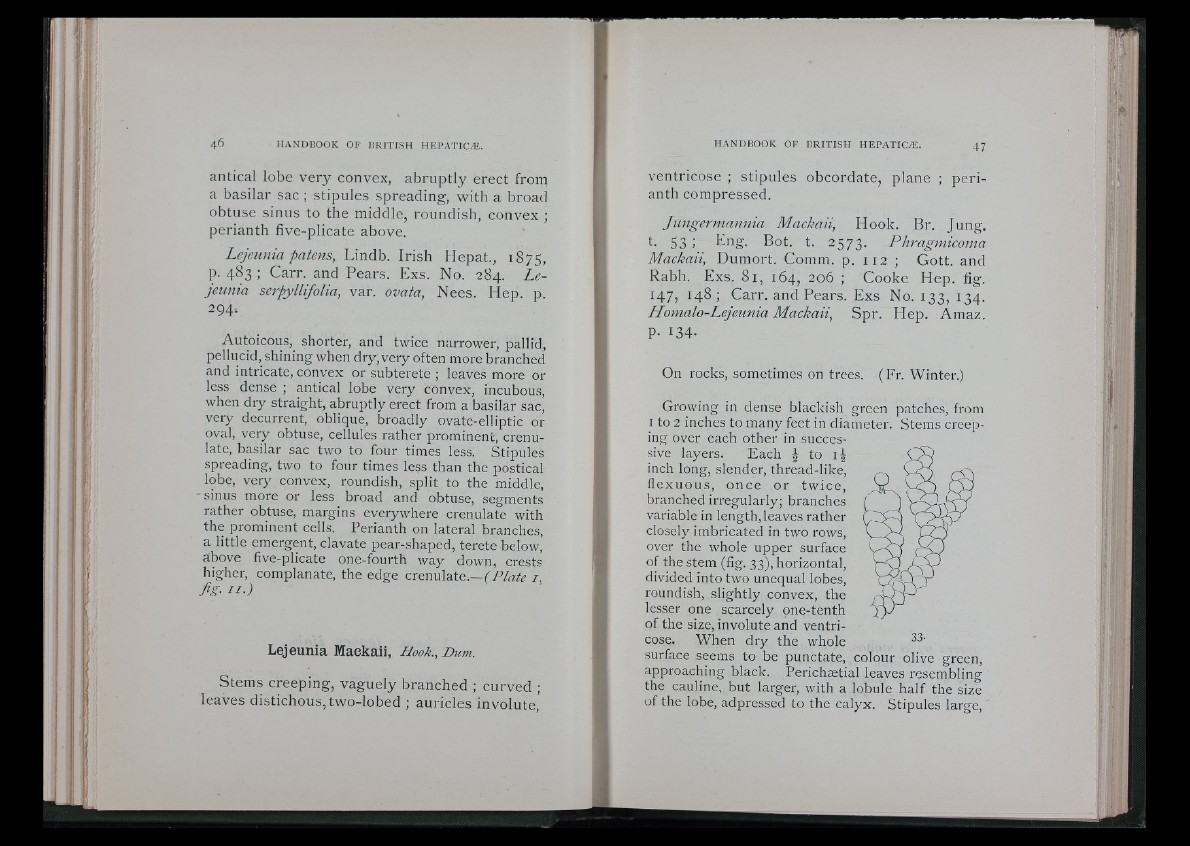
H;
46 HANDBOOK OF BRITISH HEPATICÆ.
antical lobe v e r y convex, abrupt ly erect from
a basilar sac ; st ipules spreading, with a broad
obtuse sinus to the middle, roundish, conv ex ;
perianth five-plicate above.
Lejeunia patens, Lindb. Irish Hepat., 1875,
p. 483 ; Carr, and Pears. Exs. No. 284. L e jeunia
serpyiiifoiia, var. ovala, Nees. Hep. p.
294.
Autoicous, shorter, and twice narrower, pallid,
pellucid, shining when dry, very often more branched
and intricate, convex or subterete ; leaves more or
less dense ; antical lobe very convex, incubous,
when dry straight, abruptly erect from a basilar sac,
very decurrent, oblique, broadly ovate-elliptic or
oval, very obtuse, cellules rather prominent, crenu-
latc, basilar sac two to four times less. Stipules
spreading, two to four times less than the postical
lobe, very convex, roundish, split to the middle,
sinus more or less broad and obtuse, segments
rather obtuse, margins everywhere crenulate with
the prominent cells. Perianth on lateral branches,
a little emergent, clavate pear-shaped, terete below,
ábove five-plicate one-fourth way down, crests
higher, complánate, the edge crenulate.— /,
fig- II-)
Lejeunia Mackaii, Hook., Dum.
Stems creeping, v a g u e ly branched ; curved ;
leaves dis t ichous ,two- lobed ; auricles involute,’
HANDBOOK OF BRITISH HEPATICÆ. 47
ventricose ; st ipules obcordate, plane ; pe r i anth
compressed.
Jungermannia Mackaii, Hook. Br. Jung,
t- 53 ; ting- Bot. t. 2573. Phragmicoma
Mackaii, Dumort. Comm. p. 112 ; Gott. and
Rabh. Exs. 81, 164, 206 ; Co o ke Hep. fig.
147, 148 ; Carr, and Pears. Exs No. 133, 134.
Homalo-Lejeunia Mackaii, Spr . Hep. Ama z .
P- 1 3 4 -
iil <
cl V
On rocks, sometimes on trees. (Fr. Winter.)
Growing in dense blackish green patches, from
I to 2 inches to many feet in diameter. Stems creeping
over each other in successive
layers. Each ^ to H
inch long, slender, thread-like,
f le xuou s , on c e or twic e ,
branched irregularly; branches
variable in length, leaves rather
closely imbricated in two rows,
over the whole upper surface
of the stem (fig. 33), horizontal,
divided into two unequal lobes,
roundish, slightly convex, the
lesser one scarcely one-tenth
of the size, involute and ventricose.
When dry the whole
33-
surface seems to be punctate, colour olive green,
approaching black. Perichaetial leaves resembling
the cauline, but larger, with a lobule half the size
of the lobe, adpressed to the calyx. Stipules large.
")1 Î :
:
I:
Ipi- i
i ' !
I I
n !
■
llll